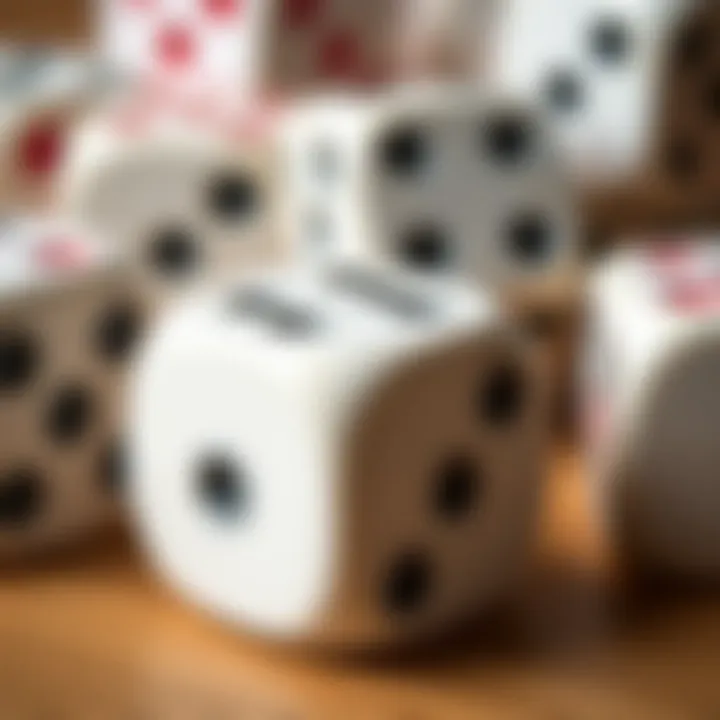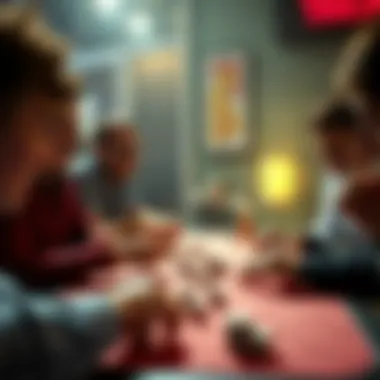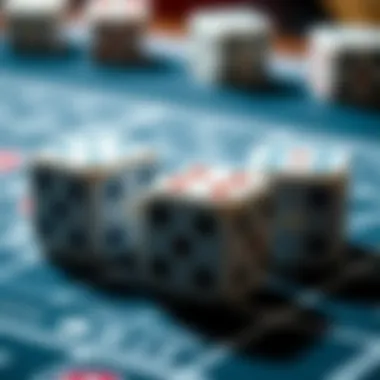Exploring the Significance of Dice in Yahtzee


Intro
In the world of games, few things are as iconic as a set of dice. As simple as they may seem, these small cubes packed with dots carry the essence of chance and strategy, setting the stage for countless moments of thrill and excitement. In Yahtzee, the dice are not merely tools for measurement—they are the heart of the game, affecting every decision made by players. Understanding their significance goes beyond just rolling; it encompasses mastering the gameplay itself.
Yahtzee relies on five dice, all of equal shape and size, yet each roll opens up a spectrum of possibilities. In this game, players strive to combine their luck with tactical choices to achieve high scores. For many, the appeal lies not just in winning, but also in the strategies that unfold around each flick of the wrist. Let's dive into how the role of dice shapes every aspect of Yahtzee, from basic mechanics to more intricate strategies.
The Power of Dice in Gameplay
The dice in Yahtzee dictate the very fabric of the game. A player’s fate can hinge on a single roll, with every combination leading to different pathways for scoring. Whether you're aiming for a full house, three of a kind, or that coveted Yahtzee, your approach to each throw greatly influences your overall strategy and potential success.
The magic of dice lies in their unpredictability. To understand this well is to unlock the game’s potential.
As players roll, they weigh options carefully; sometimes, it might pay off to hold certain dice while re-rolling others. This decision-making process is where the game really shines, as personal strategies come to light—some may favor risk, while others prefer a more conservative approach.
Key Aspects of Yahtzee Dice Mechanics
1. Dice Quantity and Functionality
In Yahtzee, players use five dice, each marked with spots from one to six. The goal is to roll the highest scoring combinations. Each number represents different scoring criteria that players can aim for, adding depth to the rolling process.
2. Various Combinations and Scoring
The game revolves around specific combinations:
- Yahtzee (five of the same number)
- Full house (three of one number and two of another)
- Four of a kind
- Three of a kind
- Small straight and large straight
These scoring categories create layers of strategy, encouraging players to not just roll dice, but to think critically about how to maximize their outcomes.
3. Impact on Game Dynamics
The dynamics of Yahtzee shift dramatically with each roll. A good roll can invigorate a player’s chances, while a bad one can leave them feeling discouraged. Learning to navigate these ups and downs shapes both the immediate game and one’s overall skill. It's essential to understand not only how to make the rolls work for you but also to adapt your strategy based on outcomes.
Closure
The role of dice in Yahtzee transcends mere game mechanics; it’s about harnessing unpredictability and skillfully shaping strategies. The interplay between chance and choice continues to captivate players old and new, drawing them into strategic battles that are as engaging as they are challenging. Knowing how to leverage your rolls effectively could mean the difference between a win and a loss. As we journey through this article, we will further explore these strategies, game combinations, and how to enhance your overall play experience.
Foreword to Yahtzee
Yahtzee is a game that transcends generations, offering not just a platform for entertainment but also a canvas for strategy, risk assessment, and, yes, a touch of luck. In this article, we will take an in-depth look at how the humble dice, the crux of Yahtzee, enhance the overall experience of the game. They are not just simple objects; they are the keys to unlocking victories and mastering the game.
History of the Game
Yahtzee’s origins trace back to the 1940s, where it began its journey as a private game enjoyed by families and friends. Initially called "Yacht", the game was primarily intended for an elite audience. It gained widespread popularity after its commercialization in the early 1950s, when it was sold by the game company E.S. Lowe. The game has since evolved, embracing various adaptations but retaining its core mechanics, which revolve around the strategic use of dice.
Historically, Yahtzee has served not only as a leisure activity but also as a subject of academic interest. The interplay of probability and strategy has made it a focal point in discussions on game theory and decision-making processes. Some say it combines the thrill of gambling with the intricacies of mathematics, making every roll a potential game-changer.
Game Objective and Basic Rules
At its heart, the objective of Yahtzee is deceptively simple: to score the highest total points possible over 13 rounds. Each player rolls the dice, attempting to create specific combinations to score, like pairs, three of a kind, or, of course, the coveted Yahtzee, where all five dice show the same number.
The basic rules can be summarized as follows:


- Each player gets three rolls per turn to achieve the best scoring combination.
- After each roll, players can set aside any number of dice and reroll others in hopes of improving their results.
- Players must choose how to score their dice at the end of their turn based on predefined categories, which introduces an element of strategic decision-making.
The game is replete with twists and turns that hinge on the outcomes of dice rolls. Players must navigate between risk and reward, often having to make crucial decisions—like whether to stick with a mediocre score or gamble for a higher one. Understanding both the mechanics of the game and the implications of each roll is essential in pursuing victory.
With this foundation laid, we delve deeper into the role of dice in Yahtzee, unraveling the intricacies of gameplay and strategy as we proceed in the following sections.
The Role of Dice in Gameplay
When diving into the world of Yahtzee, one cannot overlook the pivotal role that dice play in shaping every aspect of the gameplay. The mere act of rolling these small cubes is not just about chance, but also about strategy, decision-making, and a deeper understanding of probabilities. Each roll can lead to potential victory or defeat, making dice the heartbeat of the game. Their significance extends beyond fun and games; they serve as the primary tool for players to engage in tactical maneuvers that can ultimately dictate the outcome of their plays.
Number of Dice in Yahtzee
In Yahtzee, players utilize a total of five dice during each game. This count is essential as it sets the stage for the various combinations one can strive for, be it a full house or the coveted Yahtzee itself. A core strategy revolves around how these dice are rolled and re-rolled to maximize scoring potential. Each die carries a number between one and six, and it is this simplicity that belies the complexity of decisions faced by players.
Having five dice allows for a myriad of outcomes with each roll, presenting both opportunities and challenges. The ability to take risks by keeping certain dice while re-rolling others introduces a skillful layer to the game. Understanding how to manipulate these five dice during gameplay can be the difference between a casual game and one that dominates the scoresheet.
Dice Mechanics
The mechanics behind how dice function in Yahtzee hinge on randomness and the probability of certain outcomes. Each roll is independent; regardless of past rolls, the outcome is always fresh. However, this unpredictability does not mean players should leave everything to fate. Instead, players must cultivate a sense of when to hold onto their dice and when to take chances with re-rolls.
When rolling the dice, the chances of landing on high-value combinations vary greatly. For instance, while rolling for a Yahtzee offers a 1 in 1,296 chance under standard conditions, aiming for a three-of-a-kind from the same roll gives much higher odds. Knowing these mechanics can inform a player's approach and influence their decision-making process as they plot their way to victory.
Types of Dice Used
There are no frills with the dice used in Yahtzee; they are typically six-sided, adorned with the numbers one through six. However, the significance of these basic shapes cannot be overstated. While a set of standard dice suffices for classic gameplay, variants may incorporate differently designed dice to add a twist to the traditional format.
For example, some modern versions of Yahtzee might include dice that represent specific actions or provide a twist on standard scoring, creating layers of complexity for players. This adaptability keeps the game fresh and allows for different strategies to emerge based on the dice at hand. The combinations of faces and outcomes offered by these dice underscore not just the randomness of the game, but also highlight how players can adapt and evolve their strategies based on what is available.
"Dice are not just tools of chance in Yahtzee; they are the very foundation upon which strategies are built and victories won."
In summation, the dice in Yahtzee are far more than mere objects. They shape the gameplay, dictate strategy, and invite players into a realm of probability, decision-making, and ultimately, enjoyment. By grasping the number of dice used, the associated mechanics, and the various types that can be employed, players position themselves to not only understand the game but also improve their chances of beatin their opponents. The interplay of luck and strategy is what keeps the game enthralling and ever-evolving.
Gameplay Strategy Involving Dice
When one sits down to play Yahtzee, it’s clear that dice are central to the experience. However, the ability to effectively utilize these dice during gameplay is what truly separates the casual player from the strategist. Here, the focus shifts to how players can optimize their game strategy around the element of chance represented by rolling dice.
Understanding and mastering gameplay strategies involving dice can lead to significant advantages, especially in competitive settings. Skillful players can adapt to the unpredictable nature of dice to enhance their scoring potential while becoming more mindful of their choices at every turn. The following subsections will explore specific strategies that can be leveraged during the game.
Maximizing Your Rolls
The goal is to get the highest score possible on each turn, and this is precisely where maximizing your rolls comes into play. Essentially, it’s about making the most out of what the dice have to offer. Players often find themselves at a crossroads after the initial roll, wondering what outcomes will yield the best scores. Here are a few tips to keep in mind:
- Focus on High-Value Combinations: Aiming for Yahtzee, large straights, or full houses often outweighs going for lower-scoring combinations. When you roll, keep an eye out for the potential to create these high-value combinations.
- Consider What to Keep: Not every die rolled can lead to a great score. Sometimes, keeping a pair instead of dice that don’t complement your hand can be more productive. Remember, finding reliability in rolling certain numbers can yield better long-term outcomes.
- Understanding Risks: While it’s tempting to chase after that elusive Yahtzee, weigh the risks. Sometimes aiming for a three of a kind is a safer bet, especially early in the round.
When to Reroll
The decision to reroll is where many players stumble. Knowing when to reroll can be the difference between winning and losing; thus, careful consideration is paramount. Here’s a breakdown of when it may be prudent to take that leap of faith:


- Subpar Initial Rolls: If your first roll yields no promising combinations, do not shy away from a reroll. For example, starting with three unrelated numbers often warrants throwing them back for a fresh chance.
- Chasing Yahtzee: If you’ve rolled four of a kind, hold those and reroll the last die. The likelihood of hitting Yahtzee this way is considerably increased.
- Strategic Choices: Sometimes, keeping certain numbers that tie into future rounds can be a strategic choice. If you already have a pair but need a chance at a larger combination, hold onto the pair and reroll the rest.
Discerning Patterns and Probabilities
Lastly, players must also grasp that Yahtzee is not merely about rolling dice but understanding the math behind the odds. Discerning patterns and probabilities can help in making informed decisions:
- Recognize Probabilities: It’s essential to familiarize oneself with the probabilities associated with rolling dice. For example, the combinations that can be achieved with three dice are broader than what might be obvious on the surface.
- Use Past Rolls: While each roll is technically an independent event, keeping track of prior rolls can yield insights, especially in understanding streaks or patterns of wins and losses.
- Stay Adaptable: As the game progresses, remain flexible. Each roll may provide new insights or opportunities previously overlooked, informing your strategy as the game unfolds.
In summary, weaving together all these strategies will help in fortifying one’s gameplay in Yahtzee. Whether maximizing rolls, strategically deciding on rerolls, or understanding the underlying probabilities, a thoughtful approach to utilizing dice can greatly enhance the overall gaming experience. These strategies will lead players not just to victory but also a deeper appreciation for the subtle art of dice and decision-making in one of the world’s favorite games.
Importance of Dice in Scoring
When playing Yahtzee, the dice are not just tools for generating numbers; they play a pivotal role in determining the overall scoring potential of players. Understanding the importance of turn outcomes, influenced largely by the dice, is essential for any serious player. The intricate relationship between the roll of the dice and the subsequent score sheet strategy is what often sets the experienced player apart from the novice.
The crux of scoring in Yahtzee hinges on the ability to maximize point potential based on the dice rolled.
How Dice Affect Scoring Potential
Essentially, every roll serves as a foundation for a player’s strategy for that turn. The five dice provide unique combinations and probabilities, each contributing to different scoring categories. For instance, achieving three of a kind, a full house, or even the prestigious Yahtzee depends on the numbers shown on the dice after each roll. This demonstrates how dice can establish a trajectory for potential scores.
- Categories Affected: The basic scoring categories, such as Singles, Pairs, and Yahtzee itself, depend entirely on the combination of numbers rolled.
- Strategic Decision-Making: Players often find themselves weighing the risk of rerolling dice, hoping to either maintain a good score or shift gears for a better outcome. This decision hinges on recognizing patterns and probabilities among the numerical outcomes, heavily influenced by the characteristics of dice.
For a clearer perspective, consider the following example: if a player rolls a 2, 4, 4, 5, and 6, the potential scoring paths could lead towards securing a high pair or even attempting to go for a full house if luck permits on the next turn.
The unpredictability of dice is what makes them both a challenge and an opportunity for skillful play.
High-Scoring Hands and Their Dependencies
In Yahtzee, not all combinations yield the same scoring value. High-scoring hands often depend on both the initial roll of the dice and the strategic choices made thereafter. Certain hands, like a Yahtzee or a large straight, can dramatically elevate a player's score, but getting there is not simply about hoping for good rolls—it's about the interplay between the rolls and timing.
Factors that can influence high-scoring hands include:
- Initial Roll Combinations: The numbers you get initially lay down the groundwork for possible strategic plays.
- Knowledge of Probabilities: Understanding the likelihood of rolling needed combinations during subsequent rerolls can enhance decision-making.
- Opponent Strategies: The choices your opponents make can also shift scoring opportunities, making it crucial to adapt based on the game's flow.
Each of these dependencies can color the way a player reacts to their dice. An experienced player can foresee their potential scoring paths based on not just their dice, but the entire game dynamic. This ability differentiates those who merely play for fun from those who play to win.
In summary, the dice are the heartbeat of Yahtzee, intricately woven into every aspect of scoring and strategy. The diverse possibilities stemming from each roll highlight why these small cubes hold such significance in the game.
Variations of Yahtzee and Their Dice Considerations
Different versions of Yahtzee offer not just a change of pace but also introduce unique strategies and considerations involving dice. The essence of Yahtzee remains in its gameplay; however, particular alterations in rules or dice can significantly influence play styles and outcome probabilities. This section dives into notable variations, exploring their effects on dice mechanics and strategies. Understanding these diversions is key for seasoned players as well as newcomers looking to expand their horizons in this beloved dice game.
Classic Yahtzee vs. Modern Variants
Classic Yahtzee, featuring five dice, is where it all began. The original game embraces a straightforward approach, focusing on combinations that yield high scores. Players seek three-of-a-kinds, straights, and of course, the coveted Yahtzee itself—a set of five matching dice. Traditional gameplay enforces a simple yet intriguing experience with added layers of excitement through scoring opportunities and strategic rerolls.


Modern variants have established themselves across a broad spectrum, introducing different objectives or additional dice to enhance the challenge. For instance, Yahtzee with a twist may offer a sixth die or even change the scoring categories completely, pushing players to adapt their strategies. The adaptation to new rules can engage players in a fresh way, allowing for creativity in decision-making. In these variants:
- Scoring categories differ. Players may face new criteria, such as focusing on unique combinations specific to the variant.
- The number of dice may increase or decrease. Some games might offer additional dice for more scoring options, allowing for complex strategies.
- Home rules can take precedence. Many players choose to modify classic rules to suit their preferences, leading to an even broader range of ways to play.
Overall, these variations not only shake up the gameplay but also encourage social interaction as players share differing strategies and approaches.
Impact of Different Dice in Variants
The dice themselves play an integral role across various versions of Yahtzee. While the standard game utilizes traditional six-sided dice, some modern renditions may incorporate specialized dice—each having its distinct patterns or expressions. The inclusion of unique dice impacts gameplay greatly:
- Diversity in outcomes. Customized or specialized dice can yield new opportunities or challenges for scoring. A die marked with additional symbols rather than numbers could introduce alternate tasks or goals.
- Strategic recalibrations. Players might need to reassess their strategies based on the nature of the dice in play. When dice offer unexpected outputs, it can alter reroll decisions or scoring allocations.
- Statistical relevance. Understanding the probability distributions of unique dice can put players at a tactical advantage. For instance, if a specific variant includes dice that offer greater chances for certain combinations, savvy players will adapt their rolls accordingly.
Acknowledging the influence of variants on dice and strategy allows players not only to respect the game's tradition but also to embrace its evolution over time.
Psychological Aspects of Dice Rolling
The psychology surrounding dice rolling in Yahtzee is quite intricate, shaping both the experience and the strategy of players. Understanding these psychological elements can not only enhance gameplay but also illuminate the deeper emotional investments we have in such games. The role of chance and human perception of randomness is critical, and mastering these aspects can lead players to not just improve their play, but also enjoy the game more.
Human Perception of Randomness
When players engage with Yahtzee, they come face to face with randomness—a core component of the game's allure. Yet, what exactly is randomness in a game like this? To some, it might appear as a mere roll of the dice, but in the mind of a player, it transforms into something more.
Research reveals that humans often struggle to grasp true randomness, oftentimes seeing patterns where none exist. For example, a player might believe that after rolling several low numbers in multiple rounds, they are "due" for a high roll. This perception can lead to overconfidence or frustration, impacting their decisions on whether to reroll or keep certain dice.
"Psychological biases can affect decisions in ways that mathematics cannot predict."
This disconnect between mathematical probability and human perception serves as a crucial element in Yahtzee. Players might underestimate their chances for establishing three or four-of-a-kind simply because they feel they have already rolled enough low numbers. Recognizing these biases allows players to develop better strategies—encouraging them to think critically rather than relying solely on gut feelings.
Emotion and Decision Making in Dice Games
The emotional investment players put into Yahtzee can create a rollercoaster of feelings, from elation with a satisfying full house to despair after consecutive low rolls. These emotional experiences can significantly affect decision-making, often leading to choices driven more by those feelings rather than strategic thought.
For instance, after a disappointing round, a player might choose to reroll even if their current hand has potential. On the other side of the spectrum, an exhilarating roll might embolden a player to take risks they ordinarily wouldn't consider. Emotional highs and lows can cloud judgment, pushing players to act in the heat of the moment rather than plan the next move with a clear head.
Recognizing one's emotions and how they correspond to probability can be invaluable. Players who are aware of their emotional state can better manage not just their expectations but also their tactical choices in the game. This awareness can lead to a more calculated approach in gameplay, allowing them to remain focused on strategy rather than the thrill or disappointment of the dice they roll.
In the end, the psychological aspects of dice rolling introduce a fascinating layer to Yahtzee. By diving into these elements, players can not only elevate their understanding of the game but also shape their approach to it, ensuring they experience both the strategic depth and the emotional nuances Yahtzee has to offer.
Culmination
As we draw this exploration to a close, it's imperative to reflect on the centrality of dice in the game of Yahtzee. These small cubes are not just incidental; they are the lifeblood of the game, influencing every decision and strategy players inevitably make. Engaging with dice, understanding their probabilistic nature, and devising plan based on their outcomes is what sets the seasoned players apart from the novices.
Recap of Dice in Yahtzee
To recap, Yahtzee utilizes five dice, each capable of landing on a number from one to six. This simple yet captivating mechanic creates an expanse of possibilities. With each roll, players craft strategies not only to score points but also to assess risk and opportunity. The ability to reroll dice opens up avenues for strategic thinking, where players must weigh potential gains against the likelihood of upsetting the delicate balance of the current game state. Dice colors and types may also influence certain variants, adding depth to not just how the game is played but also how it’s perceived.
In essence, the functionality of dice goes beyond mere numbers. They symbolize chance and possibility, urging players to adapt and reevaluate their game in real-time. The emotional rollercoaster tied to those rolls impacts player choices—an exhilarating push and pull that is fundamental to what makes Yahtzee gripping.
Future of Dice-Driven Games
The future of dice-driven games like Yahtzee hinges on evolving technology and player expectations. As digital platforms gain traction, the integration of augmented reality and real-time analytics could revolutionize gameplay. Imagine a scenario where a virtual roll incorporates advanced algorithms to present probabilities in real-time, allowing players to make split-second decisions based on a wealth of data streamed instantly.
Moreover, the growth of online gaming has introduced new demographics to classic tabletop games, necessitating adaptations to traditional rules to cater to a more diverse audience. Players are increasingly seeking more interactive experiences, which may lead to hybrid formats blending physical dice with digital interfaces. Collaborative gameplay and social elements could affect how dice mechanics are structured, ensuring they remain engaging in competitive contexts.















